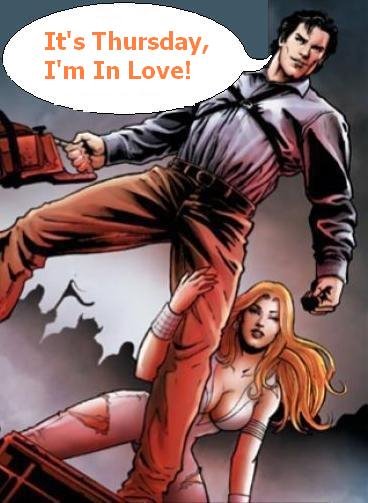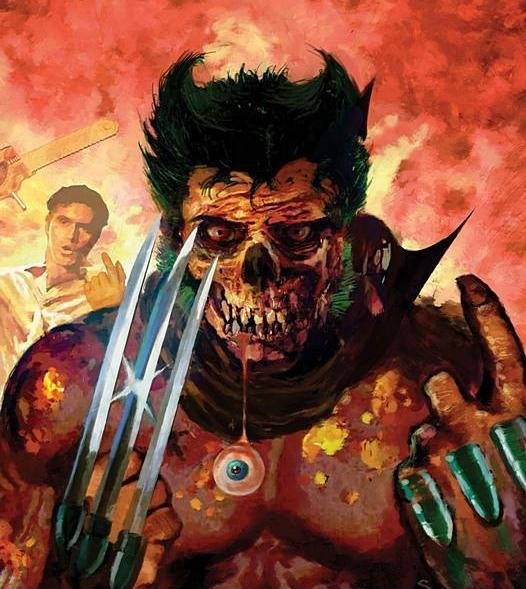‘HELLBOY 2’ UPDATE
Mike Mignola gives a behind-the-scenes scoop from the set in Prague and talks about his upcoming horror novel
By Andy Serwin | Posted August 28, 2007 9:20 AM |
Hellboy has conquered comics, animation and Hollywood, but the spotlight falls on creator Mike Mignola when his first prose novel—Baltimore, or The Steadfast Tin Soldier and the Vampire, co-written with Christopher Golden and courtesy of Bantam Books—hits bookstores today.
The fledgling novelist just returned from a trip to Prague and Budapest, where filming for “Hellboy 2: The Golden Army,” directed by Guillermo del Toro and starring Ron Perlman as the eponymous hero, is under way. He opened the book for Wizard Universe on what he saw behind the scenes of the movie and talked a bit about his first foray into prose fiction with the Gothic vampire thriller (which, by the way, is a must-read for Mignola fans and lovers of authentic horror in the vein of Bram Stoker’s Dracula).
 WIZARD: You just got back from your time in Budapest on set of “Hellboy 2: The Golden Army”; how’d your trip go?
WIZARD: You just got back from your time in Budapest on set of “Hellboy 2: The Golden Army”; how’d your trip go?MIGNOLA: It was great—and you pronounced “Budapest” correctly, which I usually don’t do. I’m constantly amazed at what del Toro’s doing. The film really looks two or three times bigger than the first picture. And since he doesn’t have two or three times as much money, I have no idea how he’s doing it. But everything looks better. The funny stuff is funnier; the creepy stuff is creepier. It’s just a beautiful-looking movie. It’s very odd, but it’s a beautiful movie.
How much of the production has been completed?
MIGNOLA: They’ve been shooting for a couple of months now, and they’re going until December, so they’re about one-third through. But I saw a lot of footage, because he edits as he goes, so I saw some kind of put-together footage. And the fact that the stuff looks as amazing as it does without all the creature effects and the CG stuff added, it’s really quite amazing.
Any plans on heading out there again before shooting wraps?
MIGNOLA: I would love to be able to go again, but I’ve got such a pile of Hellboy stuff that I’ve got started that needs to get finished that I don’t think I’ll be able to bring my head up for air before the end of the year.
What was your professional capacity on set this time around?
MIGNOLA: Mostly taking up space. Trying not to get in people’s ways. It’s always one of those things where everybody’s really nice to you, but once you leave, they’re thinking, “Thank God, one less guy who’s taking up space.” It’s so much like an army camp—everybody’s running around, everybody’s doing stuff, and you’re sitting there going, “I serve no purpose here whatsoever except to say, ‘Wow, that looks so cool.’”
 Okay, let’s switch gears and talk about the book: How did Baltimore come about?
Okay, let’s switch gears and talk about the book: How did Baltimore come about?MIGNOLA: This one came about very different than most things I’ve done. This is gonna sound weird. I was actually watching a really boring movie, my mind wandered and I made up probably two-thirds of this story in five minutes. Between the time I got bored with the movie and the time my wife and I walked out of the movie, I had made up most of the story. The movie took place in this Italian village, so it had these beautiful villas with amazing architecture with great old stone crumbling walls. And I thought I wanted to do something cool in that setting. And it just…thwppp…came out.
Within a couple days, I’d hammered out the rough spots of the story. I wanted to do it as a graphic novel, but it became real clear as a couple of years went by that I was never gonna have the time to do it as a graphic novel; the story just got too big. It just kind of sat there in the back of my head. I thought it would never get done. I got so frustrated one day, so I spoke with Christopher Golden, who’d written some of the Hellboy prose novels, and talked about collaborating on it as a novel. There’s one chapter in there that was as a Hellboy story, but the ending didn’t work for Hellboy. When we came up with the format and structure of the book, each of the characters would tell his own story, and I wanted that rambling feel in a lot of old Gothic horror stories, where one character walks in and starts telling this meandering story that seems completely unrelated. I said, “Well, I can take that Hellboy story that doesn’t work and give it to one of the main characters,” and that left me with two holes to fill to tell their experiences with the supernatural. So I handed it off to Chris and told him, “I used my puppet story here, now you go in and make up stories for the other characters.”
What was the process like putting the illustrations together?
MIGNOLA: Because I planned it as a graphic novel, I knew what visuals I wanted in the book. At first I thought I’d want about 40 to 50 illustrations, but as I went through the first draft of the book and made notes, suddenly I had a list of 250 illustrations. So there was two situations I was dealing with: If I only did 40 or 50 illustrations, they were going to disappear into this book and not really give the atmosphere I wanted. But I also wasn’t going to survive doing 250 illustrations. So I did as many as I could, and wound up with 150. But I wanted enough illustrations in the book to create this mood, so that the illustrations would remind you, “Hey, we’re in the woods now” or “We’re in this Italian village now.” I didn’t want illustrations that took away from the reader’s imagination. It’s almost like laying in a soundtrack that would establish the mood.
How did you end up landing with a major book publisher like Bantam?
 MIGNOLA: Dark Horse wanted to publish the book, and they were getting their book publishing division up and running. But I really wanted to go outside my comfort zone. I didn’t want to take them for granted and say, “Well, if no one else wanted the book then Dark Horse would publish it.” But I really wanted to see if we could get a major publishing house interested in this amazingly odd story. Chris Golden said to let him send it to all the publishers he usually deals with, and we had four major publishers who were interested in publishing the book. You just never know if anyone’s going to be interested in it unless you throw it out there. It was a great experience for me to see that book publishers wanted something that I had come up with.
MIGNOLA: Dark Horse wanted to publish the book, and they were getting their book publishing division up and running. But I really wanted to go outside my comfort zone. I didn’t want to take them for granted and say, “Well, if no one else wanted the book then Dark Horse would publish it.” But I really wanted to see if we could get a major publishing house interested in this amazingly odd story. Chris Golden said to let him send it to all the publishers he usually deals with, and we had four major publishers who were interested in publishing the book. You just never know if anyone’s going to be interested in it unless you throw it out there. It was a great experience for me to see that book publishers wanted something that I had come up with.After your success with getting Baltimore published, will we see more prose novels out of you in the future?
MIGNOLA: Chris and I hadn’t spoken since we got printed copies, but when he did call, he didn’t call to talk about the book—he called to talk about the next book. I see the beauty of this format, and I’ve got some other ideas floating around. I want to do some odd, experimental stories, but I don’t have the time in comics. I have at least one other giant graphic novel idea that’s floating around, and it’s never been cannibalized for Hellboy. The minute I sold Hellboy to Hollywood, I had to have a backup in case it got poisoned or wrecked, and this is what I came up with. That’s been sitting on the shelf for a while now, and we’re getting started on it for the next book.



No comments:
Post a Comment